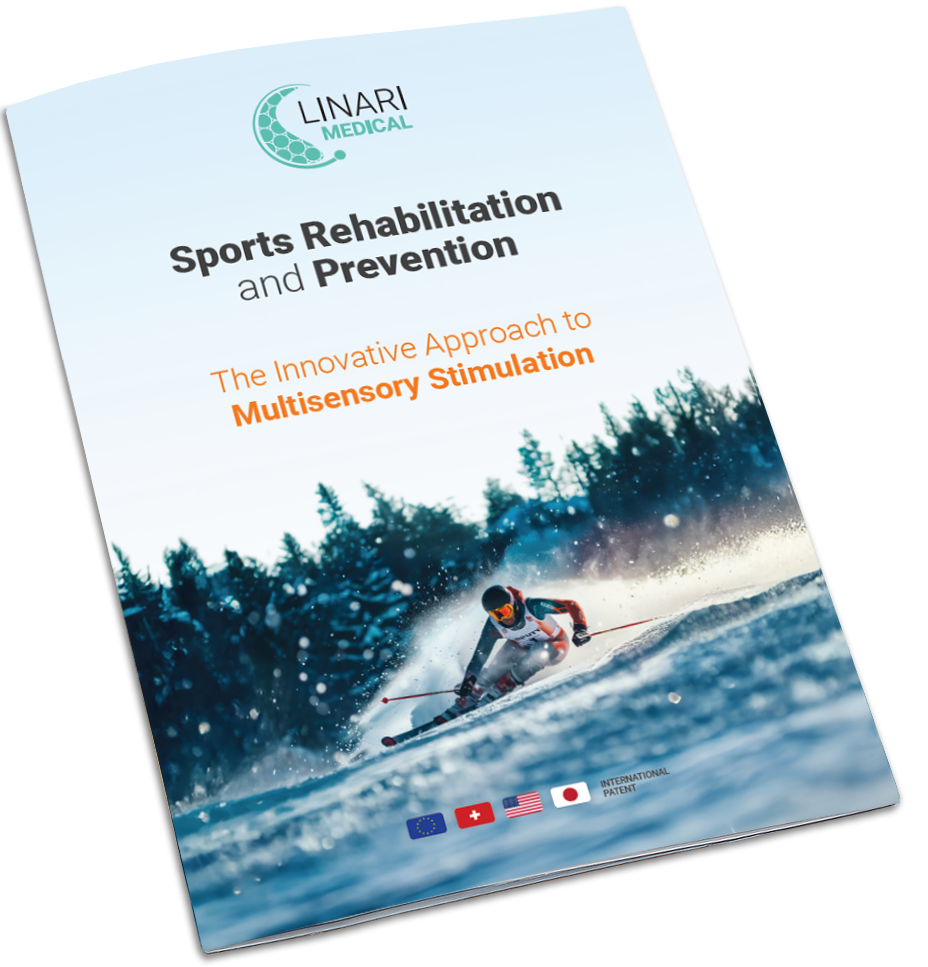Neurovisual rehabilitation of patients with geographic atrophy secondary to age-related macular degeneration with AvDesk system
Del Fabbro S, Jimenez B, Bianco L et al.DOI: 10.1177/11206721251349039
AvDesk Lift is a non-invasive medical device developed to provide a multidisciplinary rehabilitation pathway, capable of addressing visual, cognitive, and motor deficits with a single intuitive and flexible tool.
It is based on the principles of neuroplasticity, the brain’s ability to reorganize and form new connections in response to multisensory stimulation (audio and visual).
The device emits customizable light and sound stimuli, adjustable in color gradation, intensity, and frequency within the 0–2,600 Hz range.
Stimuli can be delivered individually or combined, according to the patient's therapeutic needs.
It integrates into traditional protocols for visual and motor rehabilitation as well as cognitive and sports enhancement.
AvDesk, in the Travel version, can be used independently at home, thanks to artificial intelligence that guides and monitors the user throughout the treatment duration.
Activates brain plasticity
through bimodal stimuli
Programmable visual and auditory stimuli for targeted treatments
Linari Medical Cloud platform
GDPR compliant
Face and gaze tracking
in telemedicine
Remote medical monitoring,
in asynchronous mode
Results and detailed charts
in real time
Evidence supported by
brain fMRI
Over 20 years of scientific publications supporting our work
AvDesk Lift is designed for use in:
Designed to enhance the work of rehabilitation and cognitive-visual training professionals, it is the ideal choice for:
AvDesk Lift can be used in different postural conditions, with advantages in terms of coordination, posture, and accessibility:
Standing
Visual and motor training sessions using the joystick simulate interactive scenarios or functional activities to improve coordination, reaction times, and posture.
Seated
Perfect for visual tests, cognitive exercises, or rehabilitation in ergonomic workstations, even for users with reduced mobility or undergoing recovery.
AvDesk Lift can also be used in combination with stabilometric platforms to assess and treat both visual-spatial deficits and postural and balance-related deficits in an integrated manner.
Europa

Svizzera

USA

Giappone

AvDesk can be used with cooperative and non-cooperative patients, both adults and children, affected by neuro-visual deficits, mild cognitive decline, and motor impairments.
It is a unique, intuitive, and flexible tool for clinical assessment and treatment.
of people affected by neuro-visual disabilities worldwide
Thanks to dedicated protocols, it is possible to compensate for neuro-visual disorders caused by stroke, head injury, brain tumor, or other neurological conditions:
20 hours
of treatment
success rate
of people affected by cognitive decline by 2030
AvDesk Lift enhances the cognitive abilities of patients with mild decline and vascular dementia.
Our protocols are designed to stimulate memory, attention, and executive functions, offering trackable and personalized progress.
10 ore
of treatment
success rate
of anterior cruciate ligament injuries worldwide each year
Integrated with traditional rehabilitation, neurocognitive stimulation improves post-injury recovery of the anterior cruciate ligament.
Scientific studies confirm the benefits of post-stroke motor rehabilitation with bimodal stimulation using targeted frequencies.
of treatment
12→6 months
Recovery time halved and
Zero re-injuries
A selection of over 20 years of the most recent international scientific evidence.
The validated results were published in relevant medical journals.
Neurovisual rehabilitation of patients with geographic atrophy secondary to age-related macular degeneration with AvDesk system
Del Fabbro S, Jimenez B, Bianco L et al.DOI: 10.1177/11206721251349039
Telerehabilitation for visual field defects with a multisensory training: a feasibility study
Nadia Bolognini, Lorenzo Diana, Angela Rossetti et al.DOI: 10.1186/s12984-025-01573-4
Neurovisual Training With Acoustic Feedback: An Innovative Approach for Nystagmus Rehabilitation
Damiano Antognetti, Elena Gabbrielli, Luca Allegrini, Stefania Dalise, Carmelo ChisariDOI: 10.1016/j.arrct.2024.100371
Multisensory stimulation for the rehabilitation of unilateral spatial neglect
Luca Zigiotto, Alessio Damora, Federica Albini, Carlotta Casati, Gessica Scrocco, Mauro Mancuso, Nadia BologniniDOI: 10.1080/09602011.2020.1779754
Behavioural and functional changes in neglect after multisensory stimulation
Elisabetta Làdavas, Luigino Tosatto, Caterina BertiniDOI: 10.1080/09602011.2020.1786411
Development and Implementation of a New telerehabilitation system for Audiovisual stimulation training in Hemianopia
Francesca Tinelli , Giovanni Cioni, Giulia PurpuraDOI: 10.3389/fneur.2017.00621
Neurosciences and Sports Rehabilitation in ACLR: A Narrative Review on Winning Alliance Strategies and Connecting the Dots
Rocco Salvatore Calabrò, Andrea Calderone, Nicola FiorenteDOI: 10.3390/jfmk10020119
Neurocognitive and Neuromuscular Rehabilitation Techniques after ACL injury - Part 2: Maximizing Performance in the Advanced Return to Sport Phase
Zachary Thomas , Lewis Lupowitz, Morgan Ivey, Kevin WilkDOI: 10.26603/001c.126270
Treating ACL Injury–Associated Neuroplasticity: A Neurocognitive-Motor Rehabilitation Case Study
Roberto Ricupito, Dustin R. GroomsDOI: 10.2519/josptcases.2025.0089
Neurophysiology of ACL Injury
Mikołaj Stańczak, Bram Swinnen, Bartłomiej Kacprzak, Artur Pacek, Jakub SurmacDOI: 10.52965/001c.129173
The Influence of Cognitive Dual Tasking on the Outcomes of the Triple Hop Test Following Anterior Cruciate Ligament Reconstruction
Ricupito R, Grassi A, Zanuso M, Torneri PDOI: 10.26603/001c.127511
Gamma oscillations induced by 40-Hz visual-auditory stimulation for the treatment of acute-phase limb motor rehabilitation after stroke: Study protocol for a prospective randomized controlled trial
Wang Fu, Xiaoming Yu, Minghui Lai et al.DOI: 10.1186/s13063-024-08121-w
Book a free call
to review the scientific publications

Discover the potential of multisensory stimulation in sports
The traditional rehabilitative approach is not enough.
Over 30 international publications, authored by experts in physiotherapy and neuroscience, demonstrate the effectiveness of multisensory training in the prevention and recovery of sports injuries.
Download the brochure, which includes:
Enter your details to download the brochure: